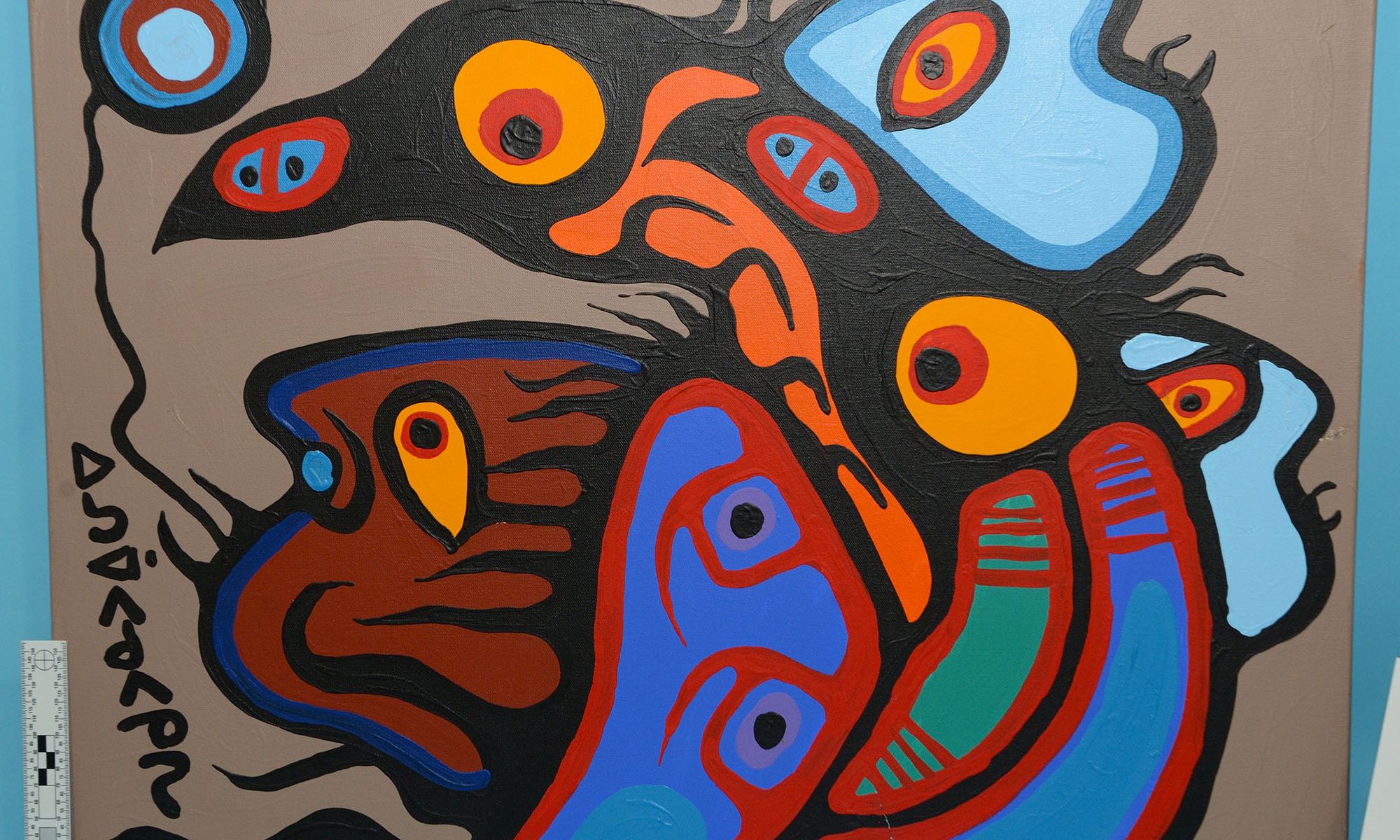A painting in the style of Norval Morrisseau seized by the Ontario Provincial Police Courtesy Ontario Provincial Police
On Thursday (5 September), David Voss—described by Crown prosecutors as the “principal architect” behind a major forgery scheme peddling thousands of fake Norval Morrisseau paintings—was sentenced to five years in prison for fraud.
The sentencing follows an announcement in March of 2023 by the Ontario Provincial Police that their investigation into a forgery ring of works by the renowned Ojibwe artist—dubbed the “Picasso of the North” by Marc Chagall—had uncovered “the biggest art fraud in world history”. The case resulted in charges against eight people, including a member of the late painter’s family, and the seizure of more than 1,000 paintings. In June of this year, Voss pleaded guilty to counts of uttering forged documents and forgery.
In her ruling, Justice Bonnie Warkentin noted that “the damage is profound” and the case has “international significance”, adding: “The legacy of Norval Morrisseau has been irrevocably damaged. His spirituality has been undermined and tarnished.”
Voss’s sentencing follows a five-year sentence for another member of the forgery ring, Gary Lamont, who pleaded guilty to two charges. Six others were charged last year. The sentencing marks a significant milestone in a case that has become a kind of Canadian cultural crucible, involving not only forgery but also abuse and exploitation of First Nations artists working in “paint by number” sweatshops, a Canadian musical icon and a documentary film.
Morrisseau—a shapeshifting self-taught artist who founded the “Woodlands School” of Indigenous art that married First Nations and Christian cosmology and traditional native and contemporary idioms—became aware of forgeries of his work on the market in the years before his death in 2007. But it was a 2019 documentary by the Canadian film-maker Jamie Kastner, There Are No Fakes, that brought the issue to wider public.
The film in turn was inspired by a lawsuit launched by Kevin Hearn—a musician in the Canadian band The Barenaked Ladies—against the Toronto-based Maslak McLeod Gallery for selling him an alleged forgery of a Morrisseau painting. The documentary helped Hearn win a C$60,000 ($44,000) award from the Ontario Court of Appeal, overturning an earlier decision in favour of the gallery citing lack of evidence of forgeries.
While the police said the film helped their investigation, Kastner fought an order to turn over his footage as evidence in the case; he told The Art Newspaper it was “a matter of principle”, that “journalism is not an arm of the police”. Nevertheless, the Ontario Superior Court ruled in favour of the police last autumn.
“It’s really fantastic that the work the film initiated continues to snowball and have real life consequences for the people that were perpetrating this awful series of crimes,” Kastner said after Voss’s sentencing. “I think [Morrisseau]’d be delighted with the ruling. We know he fought the forgeries in his lifetime and was frustrated by the same group of fraudsters now facing sentencing.”
The artist’s nephew, Benjamin Morrisseau, is still awaiting sentencing for his role in the fraud. There have been a series of alleged Morrisseau forgeries discovered hanging in prominent places, from the Ontario legislature to the Winnipeg Art Gallery and McGill University, since charges were filed last year. According to police estimates there are still more than 5,000 undiscovered forgeries produced by Voss’s ring in circulation.
“As of my writing this, Voss has shown neither remorse nor accountability for the suffering he has caused to me,” Hearn wrote in a victim impact statement read during the sentencing. “But I am just one small piece of the damage he has caused. His calculated fraud has not only stolen and utilised Norval’s identity as expressed in his work, Voss has also exploited the art world and Indigenous culture.”
The estate of Norval Morrisseau has suffered damages estimated to be near C$100m ($73.7m) due to the fraud, but according to Cory Dingle, the executive director of Morisseau’s estate, “Voss's cooperation has led to the identification of approximately 1,800 paintings as counterfeit. This pivotal information has enabled the Morrisseau Estate—with the help of our pro-bono legal team at Mishcon De Reya—to secure forfeiture and recovery of these works.”
In a statement emailed to The Art Newspaper, Dingle added: “Nearly 500 fraudulent works have already been removed from the market, a substantial step in curbing the spread of these forgeries.”
He also urged owners of Morrisseau paintings to reach out to the dstate, noting: “Your cooperation is vital in compiling an official catalogue and establishing a thorough record of counterfeit works.”

